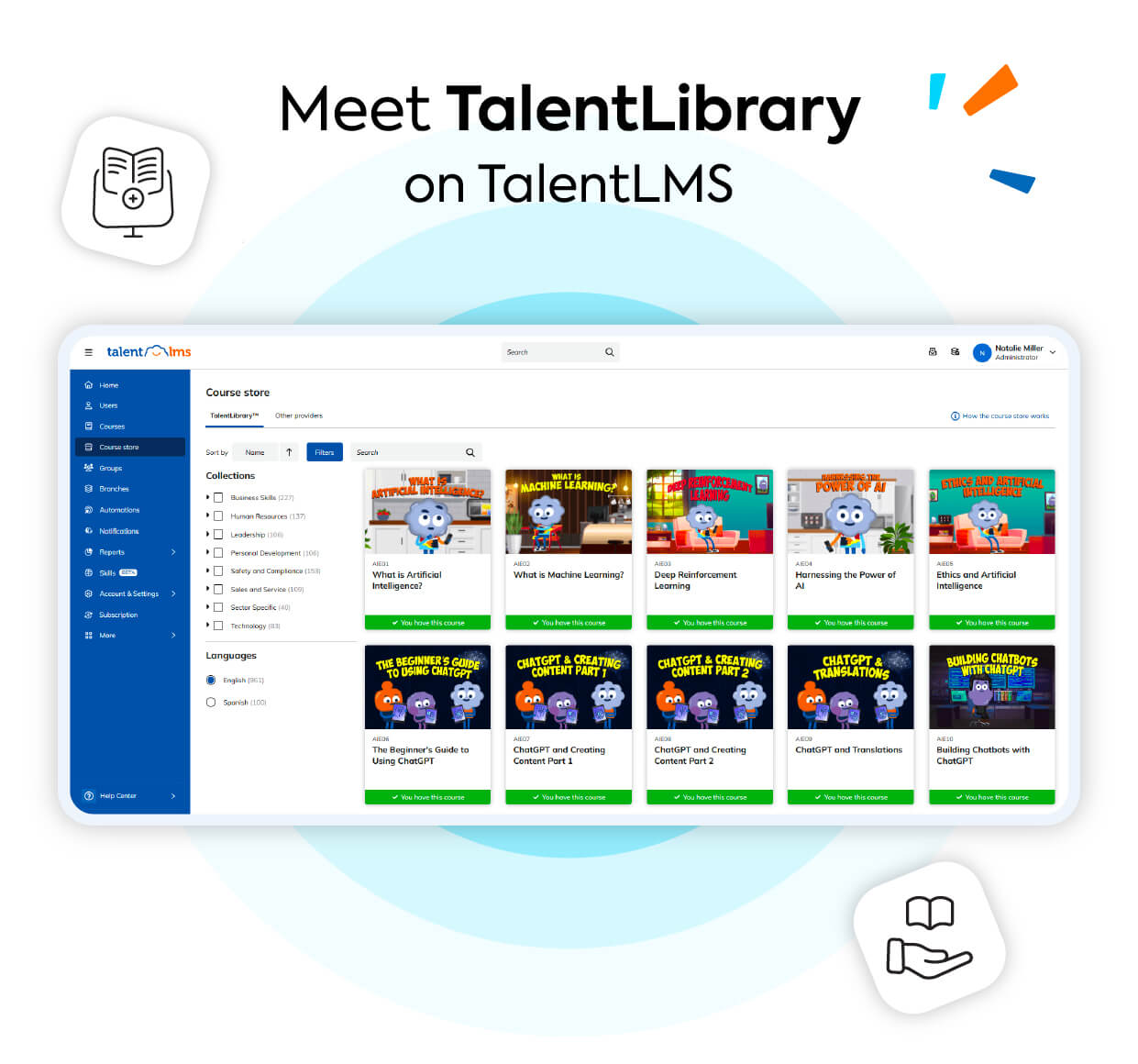Your online training program has all the essentials. You’ve made sure your content is up-to-date, you’ve added quizzes to make your courses more interactive, and you’ve even included some post-training surveys to gather feedback.
Your training is set for success. However, you may still notice low employee performance. And this can be both individual and team performance. Or, decreased satisfaction and productivity levels. So, is it possible that your training doesn’t cover current performance gaps? Or it doesn’t cover your employees’ training needs? To build successful training programs, you need to know first what you’re trying to improve.
In this article, we explore how to pinpoint and close performance gaps in your business by conducting a training needs analysis.
Getting to know performance gaps
Performance gaps can happen anytime, anywhere, and at any level and department of your organization. It’s common to identify them while conducting a performance gap analysis or training needs analysis.
However, identifying them is not enough. If you don’t succeed in addressing performance gaps, there’s a great possibility they will spread through all the departments of your business. And cause problems that will cost more time and money to fix.
For instance, you might notice that one of your sales employees is missing their targets. This, in turn, affects the whole sales team as they’re missing their monthly objectives as a group. Or, there might be delays in manufacturing. Products are not ready in time, not shipped early enough, and you result in a lot of customer complaints which, in turn, affect your customer service team. These are some performance gap examples and how they can cause issues for the whole organization if left untreated.

Identifying and addressing performance gaps in your organization
While exploring ways of identifying and tackling employee performance gaps, it’s necessary to see which are their most common causes:
- Lack of clarity
- Poor leadership
- Unrealistic expectations
- Lack of motivation and poor engagement
- Skill and talent gaps
With these in mind, let’s delve into how you can identify and address performance gaps so that you stay ahead of productivity hurdles in your organization.
1. Clarify learning objectives and outcomes
Your organization must clearly define its learning objectives and desired outcomes in order to focus on the appropriate employee performance behaviors. For example, you might want to improve your customer satisfaction scores or reduce your product return rates. As a result, you should concentrate on the training areas that pertain to these particular goals.
You can create online training courses that impart product knowledge to your employees so that they can pass it on to consumers, thereby increasing customer loyalty and decreasing the risk of returns. Meet with managers, department heads, and stakeholders to figure out what you need to achieve through your online training initiatives.
2. Determine the necessary skills and knowledge
The next step is to align your outcomes and learning objectives with employee skills and knowledge. This involves a detailed breakdown of the tasks involved, as well as the talents and skills employees require to complete these tasks. Even the smallest businesses have specific skills and knowledge their employees need to obtain through proper training.
As an example, persuasion or communication skills are necessary to enhance sales performance or IT troubleshooting abilities to improve the effectiveness of your technical service team. Create a list that features all of the desired outcomes, then link it to performance behaviors and their respective skills.
3. Identify performance pain points with a training needs analysis
Now that you know what your organization needs, you must get to the root of the problem. This involves identifying skills gaps that hinder overall productivity. Here are a few of the ways that you can conduct a training needs analysis to diagnose the problem:
eLearning assessments
eLearning assessments give a good indication of what employees know versus their training needs. They can go a long way in identifying employee’s current performance and skills gaps on an individual level. Then, you can use your LMS to pinpoint patterns and trends that demonstrate more widespread issues.
For example, employees participate in an online training simulation. The corresponding LMS graph shows that 50% of participants were unable to complete the task from start to finish and stopped at a particular point. As a result, you can easily be aware of which specific gaps have emerged during training and then create a new training strategy to bridge them seamlessly.
Observations
Monitor employees on the job or during a task-based scenario or simulation in the remote/hybrid work environment. Make sure to note down any areas for improvement.
For instance, a majority of your customer service employees have trouble with the POS terminal or are unable to use their communication and conflict resolution skills to appease an angry customer. Using the data you have collected through the monitoring stage of your training needs analysis can help you create a targeted plan of action.
Surveys
Employees may be able to shed more light on the performance issues hiding beneath the surface. For example, ineffective online training courses or company policies that are holding them back. Conduct polls, surveys, and focus groups to gather employee feedback directly.
Another great way to collect their input is to host a live webinar where you field their questions and concerns, or social media groups and discussion boards that allow them to discuss important topics and training ideas with their peers.
Evaluations
Take a closer look at quarterly or annual manager evaluations to look for patterns. For instance, you’ve decided to examine more carefully a quarterly evaluation report and notice there’s a common theme among your sales staff.
Based on the reports, they seem to lack the necessary product knowledge to achieve their monthly goals. This is solid proof that performance gaps and specific training needs are present. So, you should readjust your training strategy in order for it to be effective. To make sure it hits the spot next time, you can also follow up with team leaders for clarifications or suggestions. For example, offering tips on how to remedy the performance problem before it escalates might be particularly useful.
4. Prioritize performance issues based on organizational goals
There are only so many online training resources and training hours that you can devote to performance management. As such, you need to prioritize the gaps based on the organizational goals you’ve set.
Meet with your L&D team to rank each of the performance gaps based on company profits, customer satisfaction ratings, and other key indicators.
For example, you might need to hit your sales targets this month in order to stay on track for your quarterly goals. Therefore, performance behaviors related to sales tasks, product knowledge, and customer service should be at the top of your list.
5. Evaluate current online training resources
You may already have online training materials that are ideally suited for your training strategy and training needs. They just need to be delivered to the right employees. In other words, you need to match employees with specific skill gaps. Or performance gaps with the relevant online training activities.
However, evaluating your current online training resources also gives you the ability to identify areas for improvement and repurpose or revise online training materials. You may also discover that your online training resources are effective, but your deployment strategy needs some work.
Think about this scenario. After talking to some employees, you might discover they aren’t able to access their online training courses on their mobile devices. Maybe the training platform isn’t mobile-friendly, or they lack digital skills and are unsure of how to use their smartphones for training. Thus, they cannot get the targeted information they need to learn on the spot.
This is definitely one of the issues that may arise when dealing with bridging performance gaps.
6. Develop an online training strategy that aligns with employee training needs
The key to success is to create an online training strategy that is centered on employees’ individual training needs, goals, and performance issues. Which online training resources can you use to impart the necessary information and build practical skills?
Are there any online training activities that facilitate real-world application so that staff can apply their newly assimilated knowledge? One of the most effective ways to fill performance gaps is to offer personalized training plans.
Every employee has unique areas for improvement that require specialized online training resources. Thus, you might consider clickable eLearning course maps, microlearning libraries, and training contracts to take a learner-centric approach that doesn’t necessarily break the bank.
Making training effective by bridging performance gaps
A training needs analysis allows you to explore the performance, skill, and knowledge gaps that affect employee productivity. As a result, your organization will be able to improve on-the-job performance and get the best results, achieve its goals, and earn a return on investment.
Originally published on: 02 Jul 2018 | Tags: Employee Training





